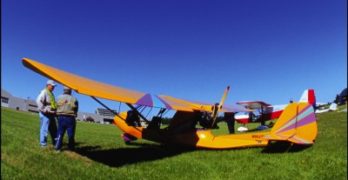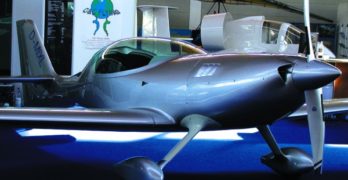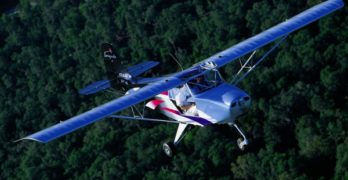ST. PAUL, MINN. — Just as the October “Product Lines” was headed to press a last-minute
update was inserted into the column by USHGA’s alert art director, Tim Meehan. At
the end of last month’s column I was writing about Alan Chuculate’s paraglider
aerotow trike, the SlowTow. A week after the deadline, Alan wrote, “The SlowTow
project suffered a major setback on Wednesday when Floyd Fronius crashed
in the trike and crushed a vertebrae and his heel. It was a classic case of a low
altitude aerotow problem resulting in the towplane pilot getting pitched down and
not releasing early enough. Both trike and glider were airborne at approximately
150 feet AGL.” Alan reports that Floyd thought the glider had released because the
towline was slack. He began to descend and turned left to reconnect and try again.
“But as he turned left the towline tightened rapidly, the glider climbed dramatically,
and the trike was slowed and pitched nose down.” Perhaps Floyd should have released
at the first sign of the problem, but it takes a short time to comprehend the situation
and he didn’t have those precious seconds.
Search Results for : Part 103
Not finding exactly what you expected? Try our advanced search option.
Select a manufacturer to go straight to all our content about that manufacturer.
Select an aircraft model to go straight to all our content about that model.
Product Lines – September 2004
OSHKOSH, WISC. — Last month I was thrilled to report the Over Everest achievement
of Richard Meredith-Hardy and fellow pilot Angelo d’Arrigo. Since then,
I established contact with d’Arrigo for a story I prepared for Kitplanes magazine
(Nov. 2004).
After I investigated the project more thoroughly, I gained a clearer picture of
the enormous challenges. So| As we left our heroes last
month, Meredith-Hardy reported d’Arrigo was being bounced around after both aircraft
flew through some high altitude turbulence. No surprise, really. In thin air at 29,035
feet the hazards are real — even if you’re standing still. According to tug
pilot Meredith-Hardy, the “time of useful consciousness is less than one minute”
without oxygen. Only with rigorous training over long periods have some climbers
made the ascent without oxygen. The temperatures are colder than a cruel Minnesota
winter with the wind howling. During their final ascent climbers take one step, rest
for a full minute, then repeat| for hours.
Product Lines – June 2004
CENTRAL FLORIDA–
At the start of the big Sun ‘n Fun airshow, I had the pleasure to fly John
Dunham’s American Tug built for him by ultralight producer, M Squared
of Alabama. This design resembles the popular Quicksilver ultralights that evolved
from the original hang glider of the late 1970s. Beefed up for the hard duty that
is aero towing, the M Squared entry is a robust ultralight that should be capable
of steady operation as a tractor of the air. American Tug is a single-place aircraft
employing a 32-foot span, high-lift, slow-flying, single-surface, strut-braced wing.
While Dragonfly has been the lone fixed-wing tug in the USA, flight parks and clubs
now have another choice. And, importantly, the American Tug — as opposed to the
“Australian tug,” John says — costs substantially less. A basic Rotax 582-powered
tug should sell for about $20,000 says John. The American
Tug I flew, with a custom-configured 680 cc Rotax engine rated at 100 hp, demonstrated
an acceptable climb rate while towing plus excellent low speed controllability.
Product Lines – May 2004
ST. PAUL, MINN. — Time is growing short! Perhaps by the time you read this, FAA
may have issued their new rule called Sport Pilot/Light-Sport Aircraft
(SP/LSA). Why should you care? Well, perhaps you don’t.
If you fly solo in your hang glider or paraglider and are not towed aloft by a tug
of some kind, you may continue to operate under F.A.R. Part 103 as blissfully as
ever. However, if you’re one of the many who enjoy aerotow launches, you may be impacted
by this rule. The good news is| the trio of Jayne
Depanfilis, Mike Meier, and Bill Bryden have been pursuing actions on the new rule
and have the matter quite well in hand. The issues of two-place flying have been
addressed and face few obstacles. Aerotowing, however, is less certain.
Operations such as Lookout Mountain Flight Park have been fighting local battles
with adversaries who brought FAA into the picture.
Tuning Up Skystar
SkyStar reorganizes to offer ultralights, homebuilts and special LSAs under “one” roof.
For the new SkyStar Aircraft Corp., the light at the end of the proverbial tunnel is not a locomotive; it’s the coming of a bright new day in light aviation. As the publication of the final sport pilot and light-sport aircraft (SP/LSA) rule looms on the horizon, business is looking better for SkyStar and most other manufacturers and suppliers of light aviation equipment.
The two-place SkyStar Series 7 will have multiple personalities. SkyStar Sport Planes will manufacture a variation of this model as a ready-to-fly special LSA. Depending on the parameters of the final rule, SkyStar Sport Planes may sell an experimental LSA kit (more than 51-percent complete). When flown as an LSA, the Series 7 will be limited to the Rotax 912S engine as its powerplant. SkyStar Aircraft will continue to offer the Series 7 as a 51- percent amateur-built kit, with a variety of engine options, including the 914 Turbo version shown here.
The Sport Pilot Rule
Increased benefits come with some costs and responsibility
Are you excited by the proposed sport pilot/lightsport aircraft (SP/LSA) rule? Many experts say the long-awaited rule will offer aviation its best growth opportunity since the 1940s. Do you wonder if any new regulation can be that helpful?
Some pilots remain apprehensive about SP/LSA. Naturally, those who will use the regulation to begin or expand their recreational flying welcome it. Some who don’t feel the need for government involvement are less sure.
Like most privileges, the new rule comes with some cost and additional requirements. Pilots of all stripes will grapple with those requirements, but it is important not to lose sight of what makes this a great piece of regulation. On this rare occasion, I find myself anticipating, even welcoming, a new federal rule.
The Costs
The proposed SP/LSA rule will reduce operating costs for many pilots, but ultralight pilots will experience some initial transition costs.
Europe’s Biggest Light Aircraft Show
Light-sport aircraft are a major part of Aero 2003
My first visit to the Aero show was in 2001. For years earlier, I’d been aware of this event in the far south of Germany, in the resort town of Friedrichshafen. After attending the show two years ago, I became aware of how important it would be to light-sport aircraft.
Because Aero runs on alternate years, like many air shows in Europe, I determined I was going again in 2003, no matter what. Once again it was a worthwhile trip.
Friedrichshafen sits on the northern shore of a giant lake called Bodensee or Lake Constance. Across the body of water to the south lies Switzerland. Bodensee’s eastern edge borders Austria. The tourist attractions generated by the big lake come with picturesque scenes in many directions.
Friedrichshafen is also home to the Zeppelin airship company. Famous for its creation of the Hindenburg, Zeppelin is the oldest continuously operating airship builder.
On An Escapade
Just Aircraft’s Excapade … certificated in England and ready for sport pilots!
Southwestern Idaho has long been a hub of aircraft activity. With ranches and towns settled in great distances, it’s not surprising that aviation, once an established mode of transportation, quickly became popular in that part of the west. It’s also not surprising, then, that the area has been a hub of aircraft building activity. Here’s the story of one aircraft that’s evolved from that heritage.
In 1983, a two-seat, steel tube and fabric aircraft called the Avid Flyer made its first appearance at EAA’s annual convention. Describing the new design in the October 1983 issue of EAA Sport Aviation, then editor Jack Cox wrote, “Dan Denney of Boise, Idaho, was the person with the idea from which sprang the Avid Flyer. He wanted ‘something between ultralights and homebuilts’|(and) Dan had a friend uniquely qualified to transform that (idea) into|an airplane, Dean Wilson.”
What Denney and Wilson demonstrated to the fly-in crowd that year might be called the forerunner of the pending light-sport aircraft category|even at a time when ultralights were still gaining their foothold.
Product Lines – March 1998
ST. PAUL, MN — Back home in the not-so-cold north (with a surprising "thanks" to El Nino), the year started off with some unhappy news. ••• In mid-January, Acme Glider Company boss Terry Reynolds wrote all TR3 owners and other interested parties. "We have given it our best and we just cannot go on any longer. We have to cease operations," he expressed. • After facing the true cost of building his exotic glider in small volume Terry concluded, "There is no chance that we can charge enough to cover reasonable costs of production and distribution at present volumes." Acme says the TR3 had direct manufacturing costs of $8,000 per glider, before accounting for R&D payoff, office expenses, and any other non-manufacturing expenses. • Acme made arrangements with Lookout Mountain’s Matt Taber to provide future support for their gliders. "Matt has assured us that he is wholeheartedly enthusiastic in taking on this project," the company reported.
Product Lines – March 1995
ST. PAUL, MINN. — Does hang gliding need to reach out for new enthusiasts? The question raises bothersome issues about declining and aging memberships, but is nonetheless a valid concern. ••• Industry leader, Wills Wing, is doing something about it by starting a new "division." They call it ProLine and its their vehicle to sell certain accessory items. Nothing new about this, you say? True, but Wills expects to do more than sell varios to their WW-brand customers. "It is our intention to use ProLine to develop products that can be marketed OUTSIDE the hang gliding industry", says a recent statement in their dealer newsletter. Naturally, they expect to raise their revenues but they further hope to increase hang gliding exposure to the public. They plan to advertise "in high circulation action sports pubications" once they have a "well developed product line." Each ProLine shipment will eventually have the USHGA color flier as well as the name of the closest WW dealer school.
- « Previous Page
- 1
- …
- 34
- 35
- 36
- 37
- 38
- …
- 53
- Next Page »





